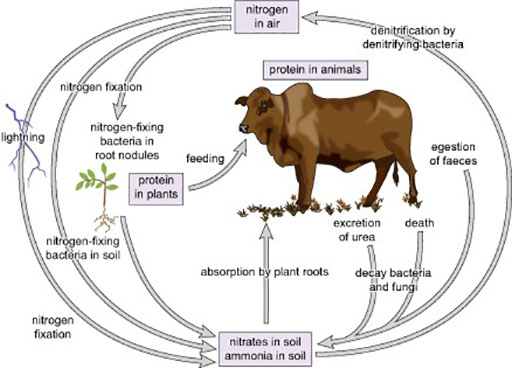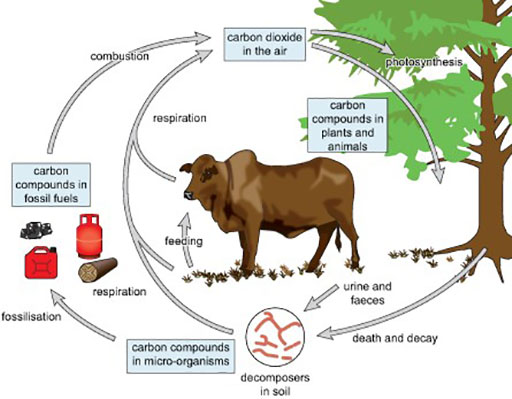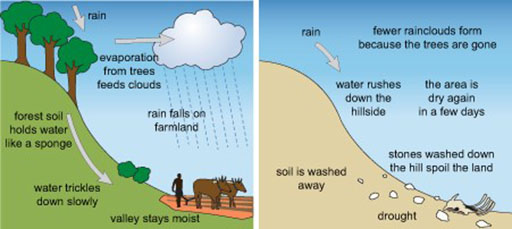Resource 3: Background knowledge for Kabwe’s story
![]() Background information / subject knowledge for teacher
Background information / subject knowledge for teacher
Solutions using biological knowledge
Knowledge and understanding of natural interactions between living organisms and their environment, including soil and water availability, can be applied to situations where human intervention has created problems. It can be used to develop solutions to help alleviate the problems.
Main areas of biology syllabus which relate to this story
- Nutrient cycles such as the nitrogen cycle and carbon cycle.
- Problems associated with human population growth and depletion of resources.
- Soil fertility, resource management and improved farming practices.
- Effects of human activity in causing deforestation, soil erosion, drought, flooding, loss of biodiversity (genetic material for future crop breeding and potential economic resources such as yet undiscovered medicines).
- Components of a healthy diet.
Scientists and communication
As well as doing and understanding science themselves, scientists must be able to explain scientific ideas to the general public and persuade them of the advantages of new techniques where appropriate. They need good communication skills. This includes listening to the views of others, analysing them critically and being prepared to learn from others. Some problems need to be solved by taking account of a balance of scientific, economic and cultural considerations.
In this story, the headman laments the lack of respect for ancestors. Biologists have a respect for the natural environment. It may be that common ground can be found by negotiation.
Listening is also important as the local knowledge of community members can be extremely valuable. This is internationally recognised as an important concept. Such knowledge should not be stolen nor its holders exploited.
Poster 1 The nitrogen cycle and the carbon cycle
Harvesting crops reduces the carbon and nitrogen going back into the soil.


Methods of conserving and renewing soil fertility
Application of manure, compost or artificial fertilisers: Removing crops at harvest interrupts natural nutrient cycles and prevents nutrients from dead remains returning to the soil to replenish nutrients. To make good the losses, farmers can apply manure, compost or artificial fertilisers. Animal manure decays to give nutrient salts. It also supplies humus which improves the water holding capacity of soils.
Crop rotation: If crops are chosen carefully this can reduce the amounts of any one mineral which is removed from the soil. It also reduces the likelihood of harmful pests and parasites building up in the area and adversely affecting crop yields. A leguminous crop is often included in the rotation so nitrogen levels can be built up in the soil due by the action of the nitrogen-fixing bacteria in their root nodules.
Poster 2 Human population growth – depletion of resources
As the population grows, more food is needed. If it is not available, people suffer from malnutrition. Also, people need to make a living and they often do so by selling resources such as timber from rainforests.
Malnutrition
This is caused by not eating enough of all the necessary components of a healthy diet. The main components of a healthy diet are protein, carbohydrate, lipid, vitamins, minerals and water.
Why traditional practices that used to be successful now need to be modified
Traditional practice of ‘slash and burn’ agriculture did no long-term damage to forests when population densities were low. Given time, the ‘bush fallow’ between clearances provided a natural rotation system that allowed the forest and its soil time to recover. Human population expansion and competing land uses such as plantation agriculture (rubber, oil palm) and hydroelectric power schemes have reduced the fallow period.
In addition to subsistence farming systems, forests are being removed for fuel wood gathering. Also, they are now being removed at an increasing rate by commercial logging for tropical hardwood timber (mainly for rich countries), for wholesale burning and clearing for cattle ranching (beef at cheap prices).
Poster 3 Soil fertility, resource management and improved farming practices
Organic practice
Organic practice focuses on maintaining a healthy and fertile soil using animal manure and compost rather than artificial fertilisers. This provides nutrients and also increases the water holding capacity of the soil. It also advocates using crop rotation. Where possible, rainwater should be collected. The need for watering can be reduced by improving the soil and growing appropriate plants. Native species should be grown where possible. Natural wildlife areas should be encouraged adjacent to crops so crop pests are controlled by natural predators.
Sustainable resource use
Where forests are cut down, for example as a timber resource, this should be done in a sustainable way. This means, with thought for future generations, i.e. as trees are cut down, new saplings should be planted.
Poster 4 The effects of human activity
Water and nutrient availability and soil erosion
Deforestation accelerates desertification by reducing rainfall. When the forest trees are cut down, the water cycle is disrupted. The reduction in transpiration (the evaporation of water vapour from the surface of the plants) results in fewer clouds and less rainfall in the vicinity. Surrounding forests are threatened by desiccation. As the land becomes hotter and drier, more of the soil is eroded.

Rainforest soils are poor in nutrients. In rainforests, virtually all the nutrients are in the organic matter of the forest canopy. Normally when dead organisms fall to the floor and are decomposed into nutrients, these nutrients are quickly reabsorbed into the living plants. If, however, the forest is felled and the trees removed, the soil nutrient source is removed too, so soils quickly become nutrient poor. The soil is of little use even for subsistence agriculture and soil erosion usually follows.
Forests are often on uplands and on watersheds. They catch and hold large amounts of rain and release the water slowly and reliably into rivers and streams. Deforestation of uplands disrupts regular water supplies and can result in much disastrous flooding of the plains below.
Trees help to stabilise soil. Deforestation results in soil erosion. This means food production is affected and can result in hunger and economic losses. Reservoirs and water supplies can silt up and harbours and estuaries must be continually dredged to keep them open.
Loss of biodiversity
Forests are extremely species rich. Their destruction will lead to innumerable extinctions of unknown and little known species, with consequent loss of genetic variety and potential resources.
Forests and climate change
Forests are an important carbon sink (together with plankton in the oceans). This is an important role within the carbon cycle. Removal of forests contributes to an increase in atmospheric carbon dioxide, which can lead to climate changes due to the greenhouse effect.
Poster 5 Components of a healthy diet
If there is not enough of the necessary types of food available, people will suffer from malnutrition. Malnutrition is caused by not eating enough of all the necessary components of a healthy diet. The main components of a healthy diet are protein, carbohydrate, fat, vitamins, minerals and water.
| Food | Rich source of | Moderate source of |
|---|---|---|
| Cereals | Starch, fibre | Protein, B vitamins, many minerals |
| Starchy roots and fruits (yams, maize, cassava, potatoes, rice) | Starch, fibre | Some minerals, vitamin C if fresh, vitamin A if yellow or orange |
| Beans and peas | Protein, starch, some minerals, fibre | B vitamins |
| Oilseeds | Fat, protein, fibre | B vitamins, some minerals |
| Fats and oils | Fat | Vitamin A if orange or red |
| Dark to medium-green leaves | Vitamins A and C, folate | Protein, minerals |
| Orange vegetables | Vitamins A and C | Fibre |
| Orange fruits | Vitamins A and C | Fibre |
| Citrus fruits | Vitamin C | Fibre |
| Milk | Fat, protein, calcium, vitamins | |
| Eggs | Protein, vitamins | Fat, minerals (not iron) |
| Meat | Protein, fat, iron | |
| Fish | Protein, iron | |
| Liver | Protein, iron, vitamins |
Resource 2: Kabwe’s Story



